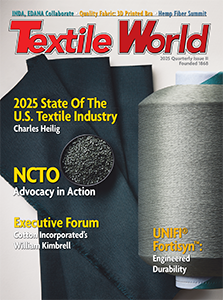Chemical TreatmentandFinishingBy Edward J. Elliott PE, Ccol, FSDC How To Prevent Metal Bits In Finished ApparelUltra sensitive magnetic metal detectors help preserve the health, safety and well being of garment sellers and buyers.

Magnetic detection had a burst of development during World War II when the search for land mines caught everyones attention. Since then, the concepts initiated during those war years have been honed with the sophisticated use of electrical engineering principals coupled with computer science to produce metal detectors which have important applications in todays industrial world.Dr. Mike Randall, chairman and Graham Millward, export sales manager, Lock Inspection Systems Ltd. hosted TEXTILE WORLDS visit to the companys manufacturing facilities in Oldham in Lancashire, England. The U.K.-based firm also operates a production plant in Fitchburg, Mass. Randall explained that one of the largest applications for metal detectors is in the textile industry. Initially it might seem that textile applications would center around finding metal in fabric as a protection to the numerous rubber/composition squeeze rolls used in wet processing. Although these areas are important, the need to detect metal in finished garments is more significant to retailers. Randall says, “We are able to detect metal bits as small as one millimeter in diameter on a continuous production line. Of serious concern are the small bits of a broken sewing needle that gets entwined within the stitches and/or seams during the sewing phase of garment assembly. Although youd like to believe that conscientious sewing machine operators would stop when a needle broke and remove fragmented pieces from garments, it isnt that simple. In many off-shore sewing plants, the operators are more concerned with productivity since it relates directly to personal earnings.” Metal detection has an important application in the food and pharmaceutical industries where metal bits can be a serious safety, health and legal problem if ingested with food or medicine tablets. Lock is able to detect minute quantities of metal fragments based on its sophisticated combination of electrical/magnetic skills and leading edge software that can significantly magnify the detector sensor signal. Lock has developed a technique that can ignore non-ferrous metallic items that are an integral part of the garment design.Millward says, “Many garment designers are using non-metallic components to assure the efficacy of the metal detector to find unwanted broken metal pieces. We now see plastic zippers, plastic or bone-like buttons, etc., all aimed at enhancing the metal detectors ability to find unwanted metal.” The specter of a mother helping a child don a new garment, only to hear fierce screams and appearance of blood from scratched parts of the childs head and body may be isolated events but are certainly real when they occur. Moreover, such an incident is “made-for-TV and the media.” Although the personal damage may look worse than it actually is, the dramatic impact of a crying toddler, a harried mother and a blood-spattered garment is more than a retailer bargains for. Its natural that retailers faced with avoiding liability for metals in foods and medicines would be the driving force behind the use of metal detectors in textiles/garments.The ability of Lock to detect 1-mm metal pieces is a result of its awareness that when a sewing needle breaks, it snaps at or below the weakest part of the needlethe eye opening where the thread passes. Usually only the pointed tip gets trapped in the seam. Normally you dont find a complete needle, since the shank is still in the sewing machine. So accuracy in finding very small metal pieces is critical.In pharmaceuticals the powders are screened to assure uniform particle size. But the stainless-steel screen-sifting wires can erode and eventually break, inserting small bits of metal into the powder. Additionally, when powders are tabletized, the tablet press must be perfectly aligned otherwise minute metal shavings can enter tablets. If either or both of these untoward conditions occur for even a short time, the need for a sensitive metal detector becomes obvious.Such innovation is proof that textiles recognizes progress made in other industries and can accept the positive thrust that gained from accurate and sensitive metal detectors. The cross-pollination between industries is a major contributor to the health, safety and well being of the textile industry and its consumers.Randall says, “Our continued R and D efforts are focused so we can apply a positive(+) influence on a potentially negative (-) problem.” October 2001




